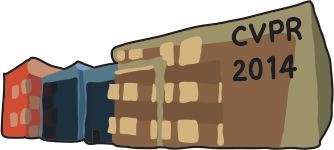-
Gauss-Newton Deformable Part Models for Face Alignment in-the-Wild
AbstractArguably, Deformable Part Models (DPMs) are one of the most prominent approaches for face alignment with impressive results being recently reported for both controlled lab and unconstrained settings. Fitting in most DPM methods is typically formulated as a two-step process during which discriminatively trained part templates are first correlated with the image to yield a filter response for each landmark and then shape optimization is performed over these filter responses. This process, although computationally efficient, is based on fixed part templates which are assumed to be independent, and has been shown to result in imperfect filter responses and detection ambiguities. To address this limitation, in this paper, we propose to jointly optimize a part-based, trained in-the-wild, flexible appearance model along with a global shape model which results in a joint translational motion model for the model parts via Gauss-Newton (GN) optimization. We show how significant computational reductions can be achieved by building a full model during training but then efficiently optimizing the proposed cost function on a sparse grid using weighted least-squares during fitting. We coin the proposed formulation Gauss-Newton Deformable Part Model (GN-DPM). Finally, we compare its performance against the state-of-the-art and show that the proposed GN-DPM outperforms it, in some cases, by a large margin. Code for our method is available from http://ibug.doc.ic.ac.uk/resources
Related Material
[pdf][bibtex]@InProceedings{Tzimiropoulos_2014_CVPR,
author = {Tzimiropoulos, Georgios and Pantic, Maja},
title = {Gauss-Newton Deformable Part Models for Face Alignment in-the-Wild},
booktitle = {Proceedings of the IEEE Conference on Computer Vision and Pattern Recognition (CVPR)},
month = {June},
year = {2014}
}
These CVPR 2014 papers are the Open Access versions, provided by the Computer Vision Foundation.
Except for the watermark, they are identical to the accepted versions; the final published version of the proceedings is available on IEEE Xplore.
Except for the watermark, they are identical to the accepted versions; the final published version of the proceedings is available on IEEE Xplore.
This material is presented to ensure timely dissemination of scholarly and technical work.
Copyright and all rights therein are retained by authors or by other copyright holders.
All persons copying this information are expected to adhere to the terms and constraints invoked by each author's copyright.

